Practice Essentials
As the nucleus pulposus loses its turgor and the elasticity of the anulus diminishes, the disk bulges outward beyond the vertebral body margins, causing bulging of the disk. Herniation of the nucleus pulposus (HNP) through an anular defect causes focal protrusion of the disk material beyond the margins of the adjacent vertebral endplate, resulting in disk herniation. [1, 2, 3, 4, 5]
Trauma is the single most common cause of rupture of the nucleus pulposus through the anulus fibrosus. The result is protrusion or extrusion of the disk material into the vertebral canal. This outcome can be caused by a single event or by repeated trauma. Predisposition to degeneration is also a factor. Alterations in the vertebral endplate cause loss of disk nutrition and disk degeneration.
MRI is the imaging modality of choice. Herniated disks are often seen on MRI in asymptomatic patients, but imaging is not indicated in patients who have signs and symptoms of a stable herniated disk until the patient has had 6 weeks of persistent symptoms. [6]
(See the images of disk herniation, below.)
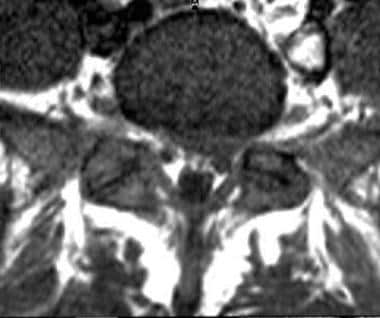 Axial T1-weighted image shows protrusion of a left paracentral disk with compression of left S1 root.
Axial T1-weighted image shows protrusion of a left paracentral disk with compression of left S1 root.
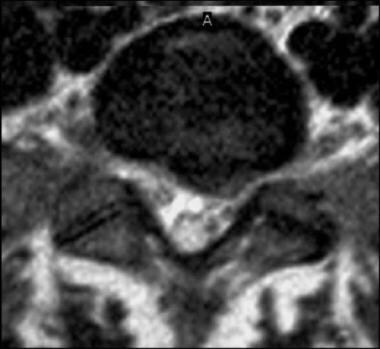 Axial T2-weighted image shows protraction of a left paracentral disk with compression of left S1 root (same patient as in previous image).
Axial T2-weighted image shows protraction of a left paracentral disk with compression of left S1 root (same patient as in previous image).
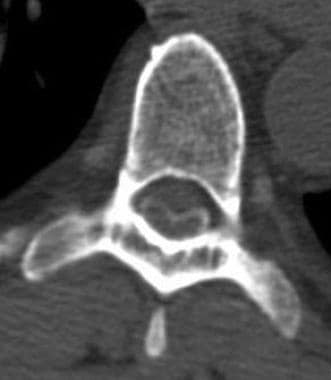 Axial CT myelogram shows a posterior central disk extrusion present at the L1-2 level; it compresses the proximal cauda equina.
Axial CT myelogram shows a posterior central disk extrusion present at the L1-2 level; it compresses the proximal cauda equina.
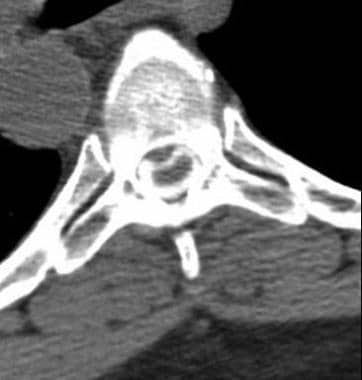 Axial CT myelogram shows posterior, central disk protrusion present at the T11-12 level. Mild cord compression is noted.
Axial CT myelogram shows posterior, central disk protrusion present at the T11-12 level. Mild cord compression is noted.
Other potentiating factors include the following [7, 8, 9] :
-
Age
-
Apoptosis
-
Abnormalities in collagen
-
Vascular ingrowth
-
Loads placed on the disk
-
Abnormal proteoglycan
-
Obesity
-
Sedentary lifestyle
-
Poor physical
Radiography
In cases of disk bulging, plain radiographs reveal indirect findings of disk degeneration in the form of loss of height of the intervertebral disk, vacuum phenomenon in the form of gas in the disk, and endplate osteophytes. Moderate bulges appear as nonfocal protrusion of disk material beyond the borders of the vertebra; this is typically broad based, circumferential, and symmetric.
In most cases of herniated nucleus pulposus (HNP), plain radiographs of the lumbosacral spine or cervical spine are not needed. Plain radiographs do not reveal disk herniation; they are usually used to exclude other conditions (eg, fracture, cancer, infection). When the clinical condition strongly suggests HNP, plain radiographs can be avoided.
Myelographic findings in patients with HNP include extradural deformity or displacement of the contrast-filled thecal sac. In addition, myelograms may show elevation, deviation, or amputation of the root sleeve and edema of the affected nerve.
When used in routine practice, magnetic resonance (MR) myelography has been shown to be of limited value. In one study, it assisted in establishing a diagnosis in only a small percentage of cases (6%). The technique was of limited additional value in patients with multilevel pathology, and it was of even less value in patients with scoliosis, for whom it was used to help establish the most likely level to account for the pathology. [15]
Computed Tomography
CT has proved to be as good as or even better than myelography alone in the diagnosis of herniated disk. CT scanning with myelography is superior to either one alone.
In subligamentous herniation, images show a focal, smooth, outward displacement of the disk margin in the spinal canal, in the neural foramen, or lateral to the neural foramen. CT scans may further demonstrate calcification or, less commonly, gas in the herniation.
In disk herniation, CT scans show a soft-tissue mass with effacement of the epidural fat and displacement of the thecal sac. If the fragment is no longer restrained by the PLL but is still in contact with the disk margin, an irregular, lobulated excrescence on the disk margin is seen. A separated disk fragment is often detected in the epidural fat adjacent to the dural sac or sheath of a nerve root. The disk margin may appear normal. The attenuation of the nuclear fragments of a fragmented disk is usually 80-120 HU.
To achieve optimal results with CT, a localizer image should be obtained at the site of pathology by using relatively thin sections and optimal resolution. A CT-based diagnosis of herniated disk is difficult in patients who have previously undergone laminectomy, because the epidural fat is partially replaced by fibrosis and the surgical scar. Deformity of the dural sac and nerve sheath, along with the bony changes, help in the diagnosis (see the images below).
 Axial CT myelogram of a large, central calcified disk extrusion present at the T5-6 level; it causes severe spinal cord compression.
Axial CT myelogram of a large, central calcified disk extrusion present at the T5-6 level; it causes severe spinal cord compression.
 Axial CT myelogram shows a posterior central disk extrusion present at the L1-2 level; it compresses the proximal cauda equina.
Axial CT myelogram shows a posterior central disk extrusion present at the L1-2 level; it compresses the proximal cauda equina.
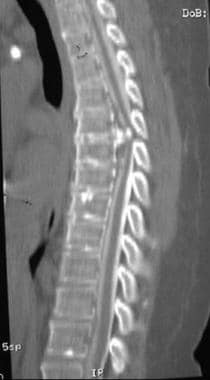 Sagittal reformatted CT myelogram shows a large, calcified, posterior central disk extrusion, causing severe cord compression at the T5-6 level.
Sagittal reformatted CT myelogram shows a large, calcified, posterior central disk extrusion, causing severe cord compression at the T5-6 level.
 Axial CT myelogram shows posterior, central disk protrusion present at the T11-12 level. Mild cord compression is noted.
Axial CT myelogram shows posterior, central disk protrusion present at the T11-12 level. Mild cord compression is noted.
Cervical disk
The uncinate processes project superiorly from the vertebral bodies posteriorly and laterally to the intervertebral disks. With wear and tear, disk degeneration and narrowing of the intervertebral spaces result in an abnormal relationship of the uncinate processes with adjacent vertebral body, resulting in sclerosis and hypertrophy of the uncinate processes. As the spinal canal is compromised by the degenerating disk, myelopathy results. When a similar process occurs in the neural foramen, radiculopathy is encountered. Cervical epidural space is naturally narrow; therefore, even small disk herniations and protrusions result in dural sac impingement.
Epidural fat that highlights lumbar intervertebral herniation is nearly absent in the cervical disk. In cervical DDD associated with hard disks, CT often reveals the hypertrophied uncinate processes and osteophytes along the disk margin. On CT scans, soft disks are often characterized by the dural sac indentation by the disk, with the disk having an attenuation slightly greater than that of the sac.
Thoracic disk
CT is helpful in diagnosing a thoracic disk when the region of interest, determined on the basis of clinical localization, is small. A thoracic disk frequently contains calcium, which is demonstrable on CT scans. A herniated disk may be seen as a clearly defined mass surrounded by epidural fat lateral to the dural sac. However, if the epidural fat is lacking, the disk appears as a mass of slightly increased attenuation that displaces the dural sac. CT findings vary depending on the amount of epidural fat and subarachnoid cerebrospinal fluid in the thoracic region.
Magnetic Resonance Imaging
MRI exquisitely delineates herniated nucleus pulposus (HNP) and its relationship with adjacent soft tissues. On MRI, HNPs appear as focal, asymmetric protrusions of disk material beyond the confines of the annulus. HNPs themselves are usually hypointense. However, because disk herniations are often associated with a radial annular fissure, high signal intensity in the posterior annulus is often seen on sagittal T2-weighted images. On sagittal MRIs, the relationship of HNPs and degenerated facets to exiting nerve roots within the neural foramina is well delineated. In addition, free fragments of the disk are easily detected on MRI (see the images below). [15, 16, 17, 18, 21, 22, 33, 34, 10]
 Axial T1-weighted image shows protrusion of a left paracentral disk with compression of left S1 root.
Axial T1-weighted image shows protrusion of a left paracentral disk with compression of left S1 root.
 Axial T2-weighted image shows protraction of a left paracentral disk with compression of left S1 root (same patient as in previous image).
Axial T2-weighted image shows protraction of a left paracentral disk with compression of left S1 root (same patient as in previous image).
 Recurrent postoperative disk extrusion at L4-5 after L4-5 diskectomy. Axial and sagittal T1-weighted images obtained before and after contrast enhancement reveal a rim of enhancing, recurrent left central disk extrusion with downward migration.
Recurrent postoperative disk extrusion at L4-5 after L4-5 diskectomy. Axial and sagittal T1-weighted images obtained before and after contrast enhancement reveal a rim of enhancing, recurrent left central disk extrusion with downward migration.
 Right S1 radiculopathy. Sagittal T1- and T2-weighted images show a large, right central disk extrusion at L5-S1 that markedly compresses the thecal sac. The extruded disk is compressing the right S1 nerve root.
Right S1 radiculopathy. Sagittal T1- and T2-weighted images show a large, right central disk extrusion at L5-S1 that markedly compresses the thecal sac. The extruded disk is compressing the right S1 nerve root.
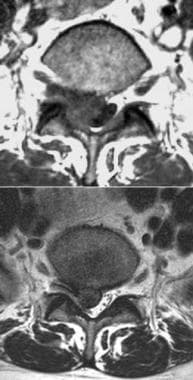 Right L5 radiculopathy. Axial T1- and T2-weighted images at L4-5 show a large, right paracentral disk extrusion causing marked compression of the thecal sac. Images show compression, but the right L5 root is not visible.
Right L5 radiculopathy. Axial T1- and T2-weighted images at L4-5 show a large, right paracentral disk extrusion causing marked compression of the thecal sac. Images show compression, but the right L5 root is not visible.
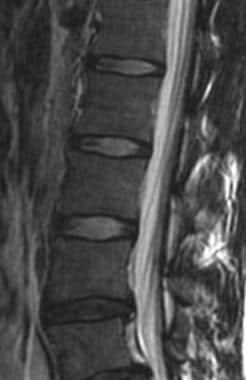 Sagittal T2-weighted imaging of lumbosacral spine shows an annular tear at L4-5 and disk protrusion at the L5-S1 levels.
Sagittal T2-weighted imaging of lumbosacral spine shows an annular tear at L4-5 and disk protrusion at the L5-S1 levels.
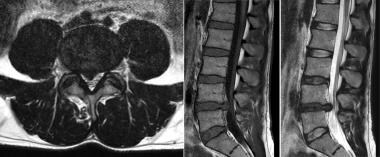 Right paracentral disk herniation at L4-5. Axial T2 and sagittal T1- and T2-weighted images obtained in a patient complaining of left-sided back pain radiating into her leg with imaging findings not correlating with her symptoms.
Right paracentral disk herniation at L4-5. Axial T2 and sagittal T1- and T2-weighted images obtained in a patient complaining of left-sided back pain radiating into her leg with imaging findings not correlating with her symptoms.
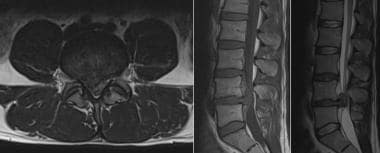 Progression of disk herniation. Axial T2 and sagittal T1- and T2-weighted images in the same patient obtained 6 weeks later shows progression of disk herniation and now superimposed disk extrusion migrating superiorly, causing severe spinal canal stenosis and severe compression of the internal cauda equina.
Progression of disk herniation. Axial T2 and sagittal T1- and T2-weighted images in the same patient obtained 6 weeks later shows progression of disk herniation and now superimposed disk extrusion migrating superiorly, causing severe spinal canal stenosis and severe compression of the internal cauda equina.
 Sagittal T1- and T2-weighted images and axial T1- and T2-weighted images show degenerative changes at the L1-2 and L2-3 levels, facet hypertrophy at the L4-5 level, and disk herniation, leading to extrusion and compressing the left L5 root.
Sagittal T1- and T2-weighted images and axial T1- and T2-weighted images show degenerative changes at the L1-2 and L2-3 levels, facet hypertrophy at the L4-5 level, and disk herniation, leading to extrusion and compressing the left L5 root.
 Sagittal T1- and T2-weighted gradient-echo images obtained at C5-6 show a moderate-to-severe central disk extrusion that causes cord compression with abnormal signal intensity in the cord. Gradient-echo images improve the contrast to distinguish between the hyperintense disk and the hypointense osteophytosis.
Sagittal T1- and T2-weighted gradient-echo images obtained at C5-6 show a moderate-to-severe central disk extrusion that causes cord compression with abnormal signal intensity in the cord. Gradient-echo images improve the contrast to distinguish between the hyperintense disk and the hypointense osteophytosis.
In cases of disk bulging, early findings on MRI include loss of the normal posterior disk concavity. Moderate bulges appear as nonfocal protrusions of disk material beyond the borders of the vertebrae; bulges are typically broad based, circumferential, and symmetric.
A radial fissure of the annulus fibrosus is considered a sign of early disk degeneration. It is accompanied by other signs of disk degeneration, such as a bulging annulus, loss of disk height, herniation of the nucleus pulposus, and changes in the adjacent endplates. Radial fissures of the annulus fibrosus can be detected as an area of increased signal intensity on T2-weighted and gadolinium-enhanced MRIs. There is an association between the annular fissure on MRIs and the symptomatic disks. [10, 11]
Raudner et al performed a 5-year follow-up study of 25 patients with symptomatic low back pain and found that quantitative T2 mapping may serve as a clinically feasible, noninvasive imaging biomarker that can indicate disks at risk for herniation and correlate with clinical outcome. [35]
Gadolinium-based contrast agents have been linked to the development of nephrogenic systemic fibrosis (NSF) or nephrogenic fibrosing dermopathy (NFD). The disease has occurred in patients with moderate to end-stage renal disease after being given a gadolinium-based contrast agent to enhance MRI or MRA scans. NSF/NFD is a debilitating and sometimes fatal disease. Characteristics include red or dark patches on the skin; burning, itching, swelling, hardening, and tightening of the skin; yellow spots on the whites of the eyes; joint stiffness with trouble moving or straightening the arms, hands, legs, or feet; pain deep in the hip bones or ribs; and muscle weakness.
Uncommon findings on MRI
Uncommon HNP findings on MRI include areas of atypical signal intensity and unusual location.
Some HNPs have high signal intensity on T1- or T2-weighted MRI. Vascularized extruded fragments may show ring enhancement after the administration of contrast material. Lesions in unusual locations include extraforaminal HNPs, fragments sequestered posterior to the thecal sac, and lesions located completely outside the canal (far lateral herniations). Atypical migratory disk patterns may also be seen; occasionally, migration occurs down the root sleeve. In rare cases, HNPs penetrate the PLL and extend intradurally.
A strongly enhancing HNP may mimic a neoplasm such as an ependymoma or a tumor of the nerve sheath.
Contrast enhancement does increase the yield, though minimally. Approximately 5% of patients have abnormally enhancing nerve roots consistent with neuritis; in 70% of these patients, such findings are associated with HNP or disk bulges. In the cervical and thoracic spine, contrast enhancement increases epidural conspicuity and improves diagnostic yield. It is particularly useful in delineating foraminal pathology.
In their extensive study of HNPs, Mikhael et al found that lumbar MRI and CT results were both diagnostic in cases of herniated and extruded disks. [12] MRI provided the most information about the degenerative state of the intervertebral disks. MRI was more accurate than CT in depicting small, bulging, and herniated disks without a ruptured anulus, as well as the relation of the migrated fragments of extruded disks to the back of the vertebrae and the thecal sac. In addition, MRI was more accurate than CT in differentiating postoperative epidural fibrotic changes from recurrent herniated and/or extruded disk and in depicting distal spinal cord abnormalities. CT easily depicted laterally herniated lumbar disks. Myelography was the diagnostic study in cases of arachnoiditis.
Weishaupt et al found that positional MRI more frequently demonstrated minor neural compromise than conventional MRI. [14] Positional pain differences were related to position-dependent changes in foraminal size.
Jinkins et al studied the general clinical utility of the first dedicated MRI unit that enabled upright, weight-bearing positional MRI of the spinal column during various dynamic-kinetic maneuvers (kinetic MRI) in patients with degenerative conditions of the spine. [2] Upright, weight-bearing positional MRI is thought by some to be useful.
Taneichi et al studied HNPs with gadolinium-enhanced MRI and reported that this technique depicted not only the morphology but also the pathologic changes associated with nerve root compression by herniated disk. [36] Enhanced MRI was performed in 115 patients who were surgically treated for lumbar disk herniation. Nerve root enhancement was seen in 39.1% before surgery and in 58.7% after surgery. Preoperative root enhancement reflected the intensity of radicular pain rather than the degree of neurologic deficits; by contrast, postoperative enhancement was not correlated with radicular symptoms.
Nerve root enhancement represents intraneural edema in the affected nerve root. Enhanced MRI has the potential for identifying an affected nerve root in patients in whom there is a discrepancy between the level of disk herniation and neurologic manifestations. [15, 16, 3, 20, 37]
-
Axial T1-weighted image shows protrusion of a left paracentral disk with compression of left S1 root.
-
Axial T2-weighted image shows protraction of a left paracentral disk with compression of left S1 root (same patient as in previous image).
-
Recurrent postoperative disk extrusion at L4-5 after L4-5 diskectomy. Axial and sagittal T1-weighted images obtained before and after contrast enhancement reveal a rim of enhancing, recurrent left central disk extrusion with downward migration.
-
Right S1 radiculopathy. Sagittal T1- and T2-weighted images show a large, right central disk extrusion at L5-S1 that markedly compresses the thecal sac. The extruded disk is compressing the right S1 nerve root.
-
Right L5 radiculopathy. Axial T1- and T2-weighted images at L4-5 show a large, right paracentral disk extrusion causing marked compression of the thecal sac. Images show compression, but the right L5 root is not visible.
-
Sagittal T2-weighted imaging of lumbosacral spine shows an annular tear at L4-5 and disk protrusion at the L5-S1 levels.
-
Right paracentral disk herniation at L4-5. Axial T2 and sagittal T1- and T2-weighted images obtained in a patient complaining of left-sided back pain radiating into her leg with imaging findings not correlating with her symptoms.
-
Progression of disk herniation. Axial T2 and sagittal T1- and T2-weighted images in the same patient obtained 6 weeks later shows progression of disk herniation and now superimposed disk extrusion migrating superiorly, causing severe spinal canal stenosis and severe compression of the internal cauda equina.
-
Sagittal T1- and T2-weighted images and axial T1- and T2-weighted images show degenerative changes at the L1-2 and L2-3 levels, facet hypertrophy at the L4-5 level, and disk herniation, leading to extrusion and compressing the left L5 root.
-
Axial CT myelogram of a large, central calcified disk extrusion present at the T5-6 level; it causes severe spinal cord compression.
-
Axial CT myelogram shows a posterior central disk extrusion present at the L1-2 level; it compresses the proximal cauda equina.
-
Sagittal reformatted CT myelogram shows a large, calcified, posterior central disk extrusion, causing severe cord compression at the T5-6 level.
-
Axial CT myelogram shows posterior, central disk protrusion present at the T11-12 level. Mild cord compression is noted.
-
Sagittal T1- and T2-weighted gradient-echo images obtained at C5-6 show a moderate-to-severe central disk extrusion that causes cord compression with abnormal signal intensity in the cord. Gradient-echo images improve the contrast to distinguish between the hyperintense disk and the hypointense osteophytosis.


